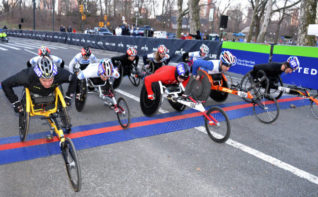Wheelchair racing takes place on both tracks and roads. It is open to athletes with any qualifying physical disability, including athletes with spinal cord injuries, amputations, cerebral palsy or other conditions. Athletes are grouped into different classes (see below) according to severity of their disabilities.
There are two techniques for propelling the wheelchair – the conventional technique (also known as the thumb technique) and the para-backhand technique (PBT).
Introduction to Wheelchair Racing (1:36)
Conventional Wheelchair Racing Stroke
There are five parts of the propulsion technique.
- 1 to 2 = acceleration phase
- 2 = impact energy transfer phase
- 3 = drive phase
- 4 = rotation force production phase
- 5 = disengagement phase; 5 to 1 = back swing.
Five Parts of Wheelchair Racing Conventional Stroke (1:59)
How to Push a Racing Wheelchair (:43)
Wheelchair Racing Tips from Sports-n-Spokes (PDF)
Getting Started with Wheelchair Racing
For wheelchair racing, participants to have to have a special racing chair and it’s recommended to purchase a used one to try it out. Then, if you want to really get into wheelchair racing, upgrade to a custom one designed to fit you exactly. You will also have to train – a lot. Wheelchair racing is a tough sport that requires a commitment to training, which most athletes agree is at least 4-5 days a week including intervals, hills and longer distance. When you feel like you’re ready, find a local race to get familiar with racing. For your first race, be sure to get there early and make sure that you and your equipment are ready to go. Remember to check your tires – change to new ones if needed and be sure they are properly inflated.
Find a Wheelchair Race
Sports n’ Spokes – The Magazine for Wheelchair Sports and Recreation – is a good place to check for wheelchair races as well as other races and events.
About Racing Wheelchairs
Racing wheelchairs are very lightweight with two large wheels and a small wheel – all have pneumatic tires. They are designed to be very lightweight and are custom-made to fit each athlete’s physique and disability.
Additional Resources
See how custom racing wheelchairs are made (2:44)
Racing Wheelchair Tire Change in 51 Seconds (1:25)
Wheelchair Racing Classifications
- T54 – completely functional from the waist up
- T53 – restricted movement in their abdominals
- T52 or T51 – restricted movement in their upper limbs
- T32–T34 – have cerebral palsy and are in a wheelchair
- T35–T38 – have cerebral palsy and can stand.
Learn about para sports events to get an idea about what’s out there and to find some ways to participate.


Leave a Reply